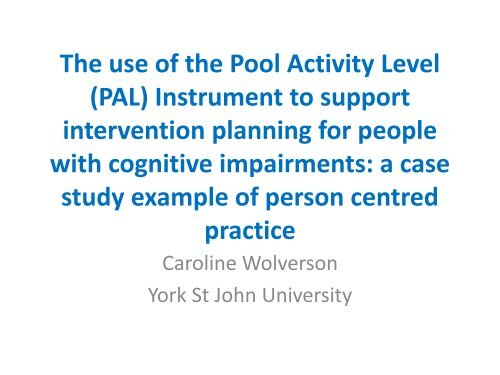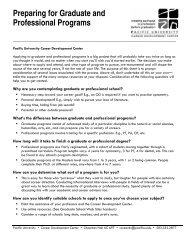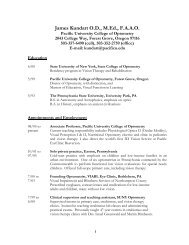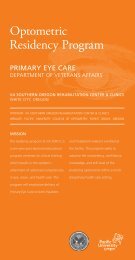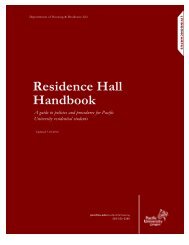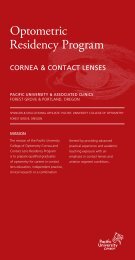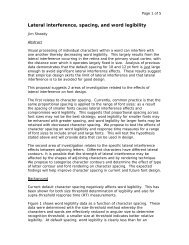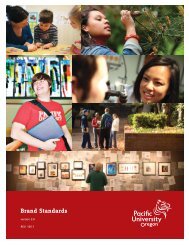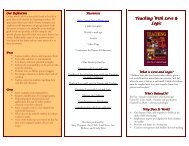The use of the Pool Activity Level (PAL ... - Pacific University
The use of the Pool Activity Level (PAL ... - Pacific University
The use of the Pool Activity Level (PAL ... - Pacific University
Create successful ePaper yourself
Turn your PDF publications into a flip-book with our unique Google optimized e-Paper software.
<strong>The</strong> <strong>use</strong> <strong>of</strong> <strong>the</strong> <strong>Pool</strong> <strong>Activity</strong> <strong>Level</strong>(<strong>PAL</strong>) Instrument to supportintervention planning for peoplewith cognitive impairments: a casestudy example <strong>of</strong> person centredpracticeCaroline WolversonYork St John <strong>University</strong>
About Fred• 69 years old.• Following a stroke 3 years previously he wasadmitted to residential care.Information on referral to community mentalhealth team:• Wheelchair dependent although can transferindependently.• On two occasions he had attempted to pushhimself into <strong>the</strong> road. Staff feel that he isdepressed. <strong>The</strong>y also state that he isaggressive towards staff & residents & attimes is sexually inappropriate & intentionallyincontinent
Initial information ga<strong>the</strong>ring/assessment• Joint visit with Community Psychiatric Nurse• Liaison with assessment <strong>of</strong>ficer from socialservices who had made referral• Information ga<strong>the</strong>ring from care home staff• No family involvement for fur<strong>the</strong>r information• Spending time with Fred• Stokes’s model was <strong>use</strong>d to ga<strong>the</strong>r initialinformation relating to <strong>the</strong> context andbehaviour that was challenging to staff
Adapted from Stokes (2002) <strong>The</strong> Holistic person-centredmodel <strong>of</strong> dementia p76SocialEnvironmentNeuropathologybehaviourPhysicalenvironmentPsychogenicfactors
Areas <strong>of</strong> difficulty for Fred• Neuropathology: medication, disability, health• Psychogenic: psychological components• Social environment: attitudes, relationships, carepractices• Built environment: – architecture, interior design• All set within <strong>the</strong> context <strong>of</strong> <strong>the</strong> care homesetting & all impacting on health, wellbeing &occupation
Neuropathology• Stroke 3 years ago – wheelchair dependent• Patchy long term memory – vascular dementiaAphasia – difficulty expressing thoughts & needs• Limited attention & concentration• Good facial recognition• Urinary & faecal incontinence on occasions• Well orientated within environment• Wears glasses• Frequent UTI’s• Emotionally labile at times• Depression?
Psychogenic factors• Experienced physical & emotional ab<strong>use</strong> as a child• Married twice – son (who became involved at a laterstage) reported he spent little time with <strong>the</strong>m• Experienced depression in <strong>the</strong> past• Intelligent man who had travelled extensively whenin Navy• Wide range <strong>of</strong> interests before stroke: classical music,golf, reading, chess, piano, walking, swimming & fineart• Used to be heavy smoker & drinker
Physical environment• Depersonalised & unstimulating environment• No personal belongings or pictures• TV & radio in room didn’t work• Wardrobe was empty• Poor view from window• Wheelchair brakes did not work• No o<strong>the</strong>r place but wheelchair to sit inbedroom
Social & cultural environment• No contact with any family• No friendships – no social contacts• Simple requests not being met• Remains in bedroom most <strong>of</strong> day• Care staff report difficulty & un-cooperative withpersonal care tasks & aggressive behaviour at times• Feels threatened & conf<strong>use</strong>d by male resident• GP suggests placement should be sought at secure unitas he is a ‘psychopath’• Belief by care staff he is inflicting self injury• Largely much older population in home with moderate –severe dementia• Environment - malignant social psychology (Kitwood1997)
Malignant social psychology withincare settings:• Person is undermined, intimidated, notresponded to, infantilised, labelled, blamed,invalidated & disempowered• Rarely done with malicious intent butinterwoven into <strong>the</strong> care cultureKitwood T(1997) Dementia reconsidered: <strong>The</strong> person comes first;Buckinghamshire; OU press
Social distance• <strong>The</strong> distance we place between ourselves &those we view as different in some way…• This can lead to <strong>the</strong> growth <strong>of</strong> myth &prejudice• Fred was living in an environment wheremalignant social psychology was dominant• Evident social distance between staff & clients
Role <strong>of</strong> <strong>the</strong> occupational <strong>the</strong>rapist• To provide comprehensive assessment <strong>of</strong>function in relation to self care, productivity &leisure to maximise function & independence
<strong>Pool</strong> <strong>Activity</strong> <strong>Level</strong> (<strong>PAL</strong>) assessment:<strong>The</strong>oretical backgroundDraws from several models <strong>of</strong> understandinghuman behaviour:• <strong>The</strong> lifespan Approach to human development(Erikson cited Atkinson, Atkinson & Hilgard1983)• <strong>The</strong> Dialetical Model <strong>of</strong> a person-centredapproach (Kitwood 1993)• <strong>The</strong> Functional Information Processing Model(Allen 1999)
<strong>The</strong> <strong>PAL</strong> Instrument comprises <strong>of</strong>:• Life History Pr<strong>of</strong>ile• Checklist describing <strong>the</strong> way a person engagesin occupations• <strong>Activity</strong> Pr<strong>of</strong>ile with general information forengaging <strong>the</strong> person in a range <strong>of</strong> meaningfuloccupations• Individual action plan• Outcome sheet
Based on <strong>the</strong> principles that:• ‘People with cognitive impairment havepotential abilities that can be realised when inan enabling environment & that occupation is<strong>the</strong> key to unlocking this potential’<strong>Pool</strong> (2008)
<strong>Pool</strong> <strong>Activity</strong> <strong>Level</strong> identifies functionbeing at one <strong>of</strong> 4 activity levels:• Planned <strong>Activity</strong> <strong>Level</strong>• Exploratory <strong>Activity</strong> <strong>Level</strong>• Sensory <strong>Activity</strong> <strong>Level</strong>• Reflex <strong>Activity</strong> <strong>Level</strong>
Planned <strong>Activity</strong> <strong>Level</strong>• Able to work towards completing activities butmay not be able to solve any problems that arisein <strong>the</strong> process• May not be able to search beyond usual placesTo facilitate participation:• Keep sentences short – avoid words such as ‘and’or ‘but’• Be present to help to solve problems that arise• Focus on activities that achieve a tangible result
Exploratory <strong>Activity</strong> level:• Able to carry out familiar activities in familiarsurroundings• Less concerned with consequences <strong>of</strong> carryingout <strong>the</strong> activity and may not have end result inmindTo facilitate participation• Requires creative & spontaneous approach toactivities• If more than 2 or 3 stages, will require activity tobe broken into manageable chunks• Simple <strong>use</strong> <strong>of</strong> memory aids such as activity lists,calendars & labelling
Sensory <strong>Activity</strong> <strong>Level</strong>• Limited Thoughts & ideas about carrying out anactivity• Concerned with sensation & moving body inresponse to those sensationsTo facilitate participation:• Guide to carry out single step activities iesweeping, winding wool• More complex activities need single stepsupported approach• Ensure <strong>the</strong> person experiences a wide variety <strong>of</strong>sensations (but avoid over stimulation)• Demonstration <strong>of</strong> actions required
Reflex activity level• Maybe unaware <strong>of</strong> surrounding environment or ownbody• Movement is generally a reflex response to a stimulusTo facilitate participation• Need to <strong>use</strong> direct sensory stimulation to raise selfawareness• Don’t over stimulate or <strong>use</strong> multiple stimuli at onetime as may have difficulty organising sensoryinformation eg avoid crowds, noisy environments• Use communication skills to enter <strong>the</strong> world <strong>of</strong> <strong>the</strong>person• Minor role <strong>of</strong> language skills but tone <strong>of</strong> voice &positive facial expressions can establish communication
Promoting Person-Centred Care at <strong>the</strong>front line (Innes A, Macpherson S, McCabe L 2006)Service <strong>use</strong>rs identified <strong>the</strong> following as being key:• Patience• compassion• sensitivity• empathy• Skills to help perform <strong>the</strong>ir role are also valued• Listening to service <strong>use</strong>r & carer views which maybe contrary to our own
Fred’s Goals• To find a new home• To be assessed for new wheelchair• To have structure & routine & choice each day• To have increased independence in personal care• To have access to leisure opportunities each day• To have opportunity for meaningful relationships• To have a detailed care plan to enable staff to valueFred, promote is health, wellbeing and engagementin meaningful & purposeful occupationFred was identified as working at a Planned <strong>Activity</strong>level
Initial action taken• Joint working with CPN & social services careco-ordinator – shared responsibility• Frequent visits to establish rapport with Fred& develop advocacy role – through thisempowered Fred to make own choices• Offer training to staff
Occupational <strong>The</strong>rapy RoleSelf Care• Providing grab rails to room to assist with transfers• Assist Fred to establish daily routine to includeindependent dressing/ undressing & independenttoileting http://dementia.stir.ac.uk/Productivity• Liaising with wheelchair service for re-assessment• Identify with Fred, role within <strong>the</strong> home ie settingtables, dusting own room, watering plants &facilitate engagement in this using <strong>PAL</strong> guide
Occupational <strong>the</strong>rapy role contd.Leisure• Working with Fred to complete life story book &<strong>the</strong>rapeutic collage (Clouston (2003), Batson et al (2002), Woods et al(2009)• Referral to volunteer befriender & supporting thisrelationship initially (Menec 2003)• Enabling access to independent leisure activities – tv,radio, sweets, keyboard, talking books (Padilla 2011)• Participation in group activities such as horticulture,music (Heathcote (2011), Chelfont (2007), Gigilotti, Jarott & Yorganson (2004)Contribution to development <strong>of</strong> detailed care plan
Outcome• Following hospital admission, Fred moved to nursinghome with continued support <strong>of</strong> mental health team• Care staff had access to biographical details toincorporate into care plan – habits, routines, likes,dislikes & facilitating activity at planned level• Volunteer befriender visited 2x weekly• Contact resumed with one son• Staff training ensured positive attitude & goodrelationships particularly with key worker• Access to sweets, daily paper, new clo<strong>the</strong>s• Goes out regularly• Ground floor room with access to garden, bird table& pots to maintain
Who was involved?• Hospital team• CPN• GP• Psychiatrist• Assessment <strong>of</strong>ficer• District Nurse• Talking Books• OpticianWheelchair servicesNursing home staffFamilyBefriender serviceContinence advisorSupport workerOccupational <strong>The</strong>rapist
Value <strong>of</strong> using <strong>the</strong> <strong>Pool</strong> <strong>Activity</strong> <strong>Level</strong>(<strong>PAL</strong>)• Recommended in <strong>the</strong> National Clinical PracticeGuidelines for Dementia (NICE 2006)• Studies show reasonably easy to complete• Useful practical resource for care staff to enablepeople with dementia to engage in meaningfulactivities (<strong>Pool</strong> et al 2008)• Contains outcomes sheet to assist with adaptingto change in function• All members <strong>of</strong> <strong>the</strong> care staff can see <strong>the</strong>ir input;<strong>the</strong>refore is empowering for staff resulting in<strong>the</strong>m being more likely to engage inimplementation (Brooker 2004)
Thoughts to take away• See <strong>the</strong> person behind <strong>the</strong> illness (Kitwood 1997)• Value people’s uniqueness and individuality• Use validation to acknowledge people’s feelings& emotions in <strong>the</strong>ir communication (Feil 1993)• Power with not power over <strong>the</strong> person• Build effective networks with o<strong>the</strong>r OT’s andservices to provide a better quality <strong>of</strong> care andaccess to services• Focus on quality <strong>of</strong> life & wellbeing throughout<strong>the</strong> OT process• Promote a positive social environment (Brooker 2004,McCormack 2004))
• Identify <strong>the</strong> person’s agenda and reconcile it withyour own• Focus on providing a positive social environmentto enable <strong>the</strong> person with dementia toexperience relative well-being.(Brooker 2004)• Assist person to maintain ‘aspects <strong>of</strong> self’ (Sabat2006)• Support staff – if <strong>the</strong>y are not treated in a personcentredway, <strong>the</strong>y will have difficulty doing thiswith service <strong>use</strong>rs (Jacques and Innes, 1998; Ryan et al., 2004).
References• Allen CK (1999) Structure <strong>of</strong> <strong>the</strong> Cognitive Performance Models. OrmandBeach, Florida: Allen Conferences Inc.• Atkinson RL, Atkinson RC & Hilgard ER (1983) Introduction to psychology(International Edition). New York: Harcourt Brace Jonavich p96-66• Batson P, Thorne K & Peak J (2002) Life story work sees <strong>the</strong> person beyond<strong>the</strong> dementia. Journal <strong>of</strong> Dementia Care. 10: 15-17• Brooker D (2004) What is person centred care? Clinical Gerontology.12:215-22• Chelfont G (2007) <strong>The</strong> dementia care gardent: Part <strong>of</strong> daily life & activity.Journal <strong>of</strong> Dementia Care 15 (6) p24-27• College <strong>of</strong> Occupational <strong>The</strong>rapists (2007) Recovering ordinary lives: Avision for <strong>the</strong> next 10 years.http://www.cot.co.uk/sites/default/files/publications/public/ROL-Vision-2010.pdf [accessed 20.03.12]• Coulston T (2003) Narratives methods: talk, listening & representation.British Journal <strong>of</strong> Occupational <strong>The</strong>rapy. 66 136-141• Department <strong>of</strong> Health (2001) National Service Framework for Older Peoplehttp://www.dh.gov.uk/en/Publicationsandstatistics/Publications/PublicationsPolicyAndGuidance/DH_4010161 [accessed 13.03.12]• Department <strong>of</strong> Health (2009) National Dementia Strategyhttp://www.dh.gov.uk/en/Publicationsandstatistics/Publications/PublicationsPolicyAndGuidance/DH_097629 [accessed 13.03.12]
References• Department <strong>of</strong> Health (2011) No Health without Mental Healthhttp://www.dh.gov.uk/prod_consum_dh/groups/dh_digitalassets/documents/digitalasset/dh_123990.pdf [accessed 13.03.12]• Feil N: (1993) Validation <strong>The</strong>rapy http://tinyurl.com/7ybn4ee [accessed22.03.12]• Feil N & Gladys Wilson – You Tubehttp://www.youtube.com/watch?v=CrZXz10FcVM [accessed 22.03.12]• Gigilotti CM, Jarott SE & Yorganson J (2004) Harvesting health: effects <strong>of</strong>three types <strong>of</strong> horticultural <strong>the</strong>rapy activities for persons with dementia.Dementia 3 (2) 161-80• Heathcote J (2011) Natural Moments: a breath <strong>of</strong> fresh air in dementia care.Nursing & Residential Care 13 (6) 290-293• Innes A, Macpherson S, McCabe L (2006) Promoting Person centred Careat <strong>the</strong> front line http://www.jrf.org.uk/sites/files/jrf/9781859354520.pdf[accessed 22.03.12]• Jacques, I. and Innes, A. (1998) ‘Who cares about care assistant work?’,<strong>The</strong>• Journal <strong>of</strong> Dementia Care, November/December, pp. 33–7• Kitwood T (1993( Discover <strong>the</strong> person not <strong>the</strong> disease. Journal <strong>of</strong> DementiaCare 1:1 p16-17
References• McCormack, B. (2004) ‘Person-centredness in gerontologicalnursing: an overview <strong>of</strong> <strong>the</strong> literature’, International Journal <strong>of</strong> OlderPeople Nursing, Vol. 13, pp. 31–8• Menec VH (2003) <strong>The</strong> relation between everyday activities &successful ageing: A 6 year longditudinal study. Journal <strong>of</strong>Gernontological and Scientific Social Science 58: 74-82• National Institute for Health & Clinical Excellence (2006 updated2011) Dementia: Supporting people with dementia & <strong>the</strong>ir carers inhealth & social care. National Clinical Practice Guideline No. 42.London: NICEhttp://www.nice.org.uk/newsroom/pressreleases/pressreleasearchive/pressreleases2006/2006_052_nice_scie_guideline_to_improve_care_<strong>of</strong>_people_with_dementia.jsp [accessed 13.03.12]• National Institute for Health & Clinical Excellence (2008) PublicHealth Guidance 16: Occupational <strong>the</strong>rapy interventions & physicalactivity interventions to promote <strong>the</strong> mental wellbeing <strong>of</strong> older peoplein primary care & residential care. http://www.nice.org.uk/PH16[accessed 20.03.12]
References• Nursing & Midwifery Council (2009 ) Guidance for <strong>the</strong> care <strong>of</strong> older peoplehttp://www.nmc-uk.org/Documents/Guidance/Guidance-for-<strong>the</strong>-care-<strong>of</strong>older-people.pdf[accessed 13.03.12]• Padilla R (2011) Effectiveness <strong>of</strong> interventions designed to modify <strong>the</strong>activity demands <strong>of</strong> <strong>the</strong> occupations <strong>of</strong> self-care and leisure for people withAlzheimer's disease and related dementias. American Journal <strong>of</strong>Occupational <strong>The</strong>rapy 65 (5) 523-31• <strong>Pool</strong> J (2008) <strong>The</strong> <strong>Pool</strong> <strong>Activity</strong> <strong>Level</strong> (<strong>PAL</strong>) instrument for occupationalpr<strong>of</strong>iling: A practical resource for carers <strong>of</strong> people with cognitive impairment.Third Edition. London, Jessica Kingsley Publications• Sabat S (2002) Surviving manifestations <strong>of</strong> selfhood in Alzheimer’s disease:a case study’ Dementia 1 (1) 25-36• Social Care Institute for Excellencehttp://www.scie.org.uk/publications/dementia/index.asp [accessed 21.03.12]• Stokes G & Goudie F (2002) <strong>The</strong> essential dementia care handbook.Bicester, Speechmark Editions• <strong>University</strong> <strong>of</strong> Stirling: Dementia Services Development Centrehttp://dementia.stir.ac.uk/• Woods B, Spector A, Jones C, Orrell M & Davies S (2009) Reminiscence<strong>The</strong>rapy for Dementia. <strong>The</strong> Cochrane Library


